2015 Santa Cruz Nomad Carbon X01
(discontinued)
| Where To Buy | |||
|---|---|---|---|
Free shipping on orders over $50 (continental U.S. only).
International shipping available. Some exclusions apply. |
Free shipping on orders over $50 (continental U.S. only).
International shipping available. Some exclusions apply. $2,799.00
|
||
Free shipping on orders over $50 (continental U.S. only).
International shipping available. Some exclusions apply. |
Free shipping on orders over $50 (continental U.S. only).
International shipping available. Some exclusions apply. $9,399.00
|
||
Reviewed by Steve Wentz and Brandon Turman // Photos by Lear Miller
The 2015 Santa Cruz Nomad is built to be an absolute beast. Now in its third generation, it is longer, slacker, lighter, has updated VPP suspension, and even sports more travel than the previous model. 27.5-inch wheels round out the package, as well as a parts pack that's ready to rock. With all the hype around this bike it was high time to officially weigh in on the Nomad during the Vital MTB Test Sessions.

Highlights
- Carbon CC frame
- 27.5-inch wheels
- 165mm (6.5-inches) of rear wheel travel // 160mm (6.3-inches) front
- Tapered head tube
- 65-degree head angle
- 74.2-degree effective seat tube angle
- 340mm (13.4-inch) measured bottom bracket height
- 433mm (17.0-inch) chainstays
- Threaded bottom bracket
- 142mm rear spacing with 12mm through axle
- Measured complete weight (size L, no pedals): 28-pounds, 6-ounces (12.9kg)
- $6969 MSRP as tested
At the heart of the new bike is a closely guarded carbon construction process that Santa Cruz prides itself on. Their fantastic plastic frames have incredibly smooth insides, while many other brands have rough patches and inconsistencies which can result in a weaker frame and unnecessary weight. The "Carbon CC" frame is more refined from what they were even able to do a couple years ago as the technology is advancing at such a fast rate. Santa Cruz also offers a more affordable "Carbon C" version.
Looking inside the frame also reveals the most dialed internal cable routing system in existence. Santa Cruz uses small carbon tubes to make routing internal cables incredibly easy, which also eliminates the chance of cables rattling. Both stealth and external dropper post cable routing options exist as well.

The frame uses the tried and true VPP suspension design to deliver 165mm of travel. You'll notice that the lower link has been recessed on this model with a pivot above the bottom bracket, protecting the link from rock strikes and allowing the designers to really shorten up the chainstay length (the 1X drivetrain specific frame helped, too). Both links are forged, the collet-style axle pivots are easy to access, and the use of angular contact bearings helps stiffen the rear end.
Completely new geometry is another big highlight, and as always the Nomad continues to be geared towards the descents. There are no geometry adjustments, but the 65-degree head angle should suit the bike's target rider well and make for no excuses on the way down. A 340mm bottom bracket height, long wheelbase, increased reach measurements, and compact 433mm chainstays round out the package. Those wanting to get really wild can throw up to a 180mm travel fork up front.
Extra details include a threaded bottom bracket, 12x142mm rear axle, ISCG 05 tabs, and some of the best molded rubber chainstay, seat stay, and downtube guards in the industry. Mud clearance with the stock 2.3-inch Maxxis tires is acceptable with about 1cm of room for the muck. There's room for a water bottle inside the front triangle as well, though it's a tight fit so you may have to use a small bottle with some cages.

Complete Carbon CC Nomad builds start at $6,599 for the X01 option and $8,299 for XX1. Upgrades to the suspension and wheels are available from the factory, with the most expensive build running $10,669 for ENVE wheels, a FOX 36 Float RC2 fork, and RockShox Vivid Air R2C shock. Our X01 build with an upgraded shock and fork ran $6969. If you're looking to save a few bucks and aren't afraid of a few grams, the Carbon C model with X1 starts at $5,599. Or you can build it from the ground up starting with the Carbon CC frame and RockShox Monarch Plus RC3 Debonair shock for $2,999.
We were able to test the murdered out flat black Nomad, though if you prefer some color you can choose the Miami Vice tribute magenta and baby blue version.
On The Trail
As luck would have it, one of our testers actually bought a Nomad before our test and has ridden it everywhere between Colorado and California. Resort riding, shuttling, and some all day adventures were just part of the weekly routine. During Test Sessions in San Luis Obispo, California, we were able to try different suspension components and experiment on more trails to complete the experience.
The build kit on our test bike provided 800mm wide Santa Cruz carbon bars, a short 50mm RaceFace Turbine stem, and plenty of seatpost adjustment up and down to accommodate a wide range of riders. Check the reach and top tube numbers in the specs, and make sure you can work with the new sizing as it's longer than Santa Cruz bikes of the past. Our 5'10" tall tester loved the 438mm reach and 610mm effective top tube on the size Large frame. Meanwhile our 5'8" tall tester is usually between Medium and Large frame sizes, and the Medium was a better for him.
We experimented with rear shock sag settings from 30-40% while seated (30-35% is suggested), noting quite a range of performance through those different pressures. After settling on a fairly standard ~20% sag on the FOX 36 fork with the bike weighted evenly, we felt slightly rearward in our orientation, but this lent itself well to downhill use.

The bike's geometry encourages the bike to go fast, and regardless of a good or poor suspension setup the geometry will still take care of you, to a point, which really highlights how far frames have come. We would have killed to have controlled suspension and a 65-degree head angle on a DH bike just a handful of years ago, but now it's standard in a package where you have great pedaling performance to get up the hill as well. The slack head angle, relatively low bottom bracket height, and long front center all make for a bike that's made for hauling down any trail where speed is readily available, and it can come very close to DH bike speeds in rough terrain. It's really incredible how well the bike worked at the limits of our bravery and mental speed limits, a sign of a truly confidence inspiring ride.
On a casual ride, though, the Nomad might not be the best thing. At slower speeds or while you're not fully on the gas the ride can be a bit boring. Why? Because the Nomad is so capable you don't have to pick super precise lines or worry about the little stuff in your path. The trail can disappear beneath you, but that's the trade off for all the stability it offers. Sometimes we like the nature of picking lines, the challenge of keeping our feet on the pedals, or the excitement of finally nailing a tricky section we've had fits with before - the Nomad makes all of these things almost too easy. If you don't want to feel the rough stuff, then by all means bring this gun to the fight.
It responds well and does what it's told, but we wouldn't call it nimble or playful in the tradition sense. It will change lines, but be ready to muscle the bike around a bit due to its length and suspension feel. Then again, if your definition of play is to pull up hard and gap massive sections of the trail, then sure, it's "playful." It's also easy to get over the back of the bike and feel ready for anything that requires a quick front end lift.
A huge part of the Nomad's capability comes from the suspension. There were no situations where the bike didn't work well in rough terrain. The RockShox Vivid Air shock upgrade is borderline cheating, resulting in tons of control and consistency. The frame stiffness is also top notch. Really compressing the bike into corners yields a confidence that's sometimes a scarce commodity on San Luis Obispo's rockiest trails.

Due to the relatively linear mid-stroke that's typical of VPP designs, the Nomad uses a lot of travel a lot of the time. It's regressive through the sag point, then progressive after that. This allows you to sit into the travel, both aiding in smoothing out the trail and also giving the feeling of a muted ride. Despite using a lot of travel, it's still fairly difficult to bottom out. There is a pronounced ramp up at the end of the stroke which helps immensely on big landings or impacts. That's a very good thing, because odds are that you'll be moving at a high rate of speed when you do use all the travel. Small bumps disappear under the VPP suspension and Vivid Air, and the Nomad is one of the most stable we have ridden on trail chatter. The amount of travel and the quality of the Vivid's damping seem very well matched. We dare say that the capability of the Nomad would not be fully exploited with less of a shock, though the alternate RockShox Monarch Plus Debonair has proven to be a good all-around performer as well. Due to the overall progressive nature of the leverage curve it will also work very well with a coil shock.
On trails that were rocky or had ledges, the Nomad would stay very composed. It wouldn't ever kick us forward, try to spring us off, or surprise us, which is an improvement over the previous versions.

We can see how it would be easy to think of the Nomad as a purely descending machine - it does that job better than many. What really surprised us, though, is what a capable climber it is. The seat angle is very steep, giving you an upright seated riding position that feels more over the pedals than the off the back feel when standing. Owners of the previous generation Nomads will really notice this change, and it makes climbing much better than we anticipated. The fact that the Vivid Air did not have any external climb switches or settings was just fine by us given the added anti-squat that's built into the suspension design.
We were often tempted into questionable lines, and on occasion we would have to sprint into them. Santa Cruz's refinement of the VPP suspension is put to excellent use here, with the Nomad feeling very neutral during all out efforts. This is no doubt caused by the system's use of chain torque to keep the bike around the sag point, instead of extending the swingarm like some other designs. When climbing, the neutral feeling never made it seem like we were flying up the hills, but we always arrived at the top with few hassles. Other than the random pedal spike due to the low bottom bracket, the only other issue while climbing concerned the front end. There will always be a trade off for this type of steed, and in this case it's difficulty maneuvering up steep, tight turns. With a front end so far away and so slack, we really had to lean the bike over to change direction, or else it would feel like we were driving a bus at times.
Build Kit
Our X01 edition test bike came equipped with quality parts from FOX, RockShox, Maxxis, DT Swiss, WTB, RaceFace, Shimano, SRAM, e*thirteen, and Santa Cruz. At nearly $7,000 it's a bit of a let down to not see a top of the line component group, but the bulk of the money goes towards great frame quality and suspension more than anything else - components very necessary for a great ride.
As mentioned previously, our test bike had two upgrades to the stock build, including the FOX 36 Float RC2 fork and RockShox Vivid Air R2C shock. Were they worth it? We think so. The behavior of the 36 coupled with the Vivid Air on the rear made encouraged us to make otherwise questionable decisions, and the adjustability of the compression and rebound in both the front and rear of the bike made for a highly tunable ride. We can't overemphasize how much we appreciate not having extra knobs and levers on the bars, and instead of on/off switches, tuning adjustments that actually make a difference. The 36 had very smooth action and compression control, as well a stout chassis that pairs well with the frame. We also like the Vivid Air's ability to tune the beginning and ending of the rebound circuits independently. These adjustments could be overkill for some people, or some terrain, but for the Nomad it all seemed to fit and align with the purpose of going through rough terrain quickly.

On the tire side of things, the 2.3-inch Maxxis High Roller II treads aided in the bike's stable, capable feel. They roll surprisingly well for the size, and we had no issues with flats thanks to the Tubeless Ready design and EXO casing. While we'd prefer a little more predictability when really leaning the bike over in flat turns (especially once the side knobs start to peel away after a few weeks of use), braking is great and traction while climbing is good, so all in all they're solid performers.
The wheels were entirely capable, and we like the fact that normal spokes, rims, and very reliable hubs were all in place for easy service. The decently wide profile of the WTB Asym i23 rims gave the tires a good seat, and the solid engagement on the DT Swiss 350 hubs was just as we have come to expect. In the several months one of our testers has had with the same wheels there have been a few dents here and there, but nothing too bad considering the WTB rim is one of the lightest available for its width.
Shimano's XT brakes handled stopping duties with dual 180mm rotors, and it's reassuring to not write much more about them other than they were exactly as we have come to know. They're reliable, fade free on all but the longest descents, and easy to adjust. We do wish they would fit on the bar better with some of SRAM's product offerings, however. The dropper post, shifter, and brake levers coming from different companies made for a cluttered bar clamp area with reduced customization options.
Coupled with RaceFace Turbine Cinch cranks and their 32-tooth Narrow/Wide chainring, we didn't have any issues with the SRAM X1/X01 drivetrain. The addition of a E13 XCX top guide means the occasional chain drop is no longer a concern. The whole system works very quietly thanks to to the clutched rear derailleur and excellent swingarm protection that comes standard.
Finally, Santa Cruz includes a 150mm travel RockShox Reverb Stealth dropper post that worked perfectly well. The extra 25mm of travel allows you to move the bike around even more on those really steep descents and jumpy trails.
Long Term Durability
Considering the fact that this bike should be purchased for the purpose of going downhill quickly, we would only worry about the relatively lightweight rims. They will hold up fine for a while, but they are not the perfect match strength wise for how capable the rest of the bike is. Other than that, the frame features an easy to use grease port on the lower link, as well as double sealed pivots for better bearing life. It's easy to take care of all areas that could be stressed with heavy use. The company backs the frame with a five year frame warranty and lifetime on the pivots.

What's The Bottom Line?
There is no Dr. Jekyll and Mr. Hyde here, the latest edition of the Santa Cruz Nomad is 95% Hyde. We have not ridden a more capable bike with this amount of travel. If your motto is "go fast, have fun, safety third," this could very well be your calling. Only its surprising ability to climb well makes us believe it really was intended to go up and down. Just remember, this is not a bike for the lazy, as it can morph crazy trail sections into rideable terrain under a motivated rider, but at the same time your average trail might end up feeling a bit more boring than you ever intended.
Visit www.santacruzbicycles.com for more details.
Bonus Gallery: 21 photos of the 2015 Santa Cruz Nomad Carbon X01 up close and in action
About The Reviewers
Steve Wentz - A man of many talents, Steve got his start in downhilling at a young age. He has been riding for over 18 years, 11 of which have been in the Pro ranks. Asked to describe his riding style he said, "I like to smooth out the trail myself." Today he builds some of the best trails in the world (and eats lots of M&M's).
Brandon Turman - Brandon likes to pop off the little bonus lines on the sides of the trail, get aggressive when he's in tune with a bike and talk tech. In 15 years of riding he worked his way through the Collegiate downhill ranks to the Pro level. Formerly a Mechanical Engineer, nowadays he's Vital MTB's resident product guy.

About Test Sessions
Three years ago Vital MTB set out to bring you the most honest, unbiased reviews you'll find anywhere. That tradition continues today as we ride 2015's most exciting trail, all-mountain, and enduro bikes in San Luis Obispo, California. Reviews can be accessed 24/7 in our Product Guide. Test Sessions was made possible with the help of Foothill Cyclery. Tester gear provided by Five Ten, Race Face, Easton, Troy Lee Designs, Club Ride, Kali, Royal, Smith, Pearl Izumi, and Source.
1 member reviews
Light weight and stiff.
Simple yet brilliant frame design.
Frame built to last.
Excellent customer support from company.
Could have more rubber frame guards.
Swapped our my Trek Slash for this bike. I'm a professional mechanic and avid freerider and there are a few things that lead me this way.

Geometry, long and low. I'm 6' 3" and need an XL frame but most XL frames (including my Slash) has a seattube so darn high I get bucked in the steep, buttpucker lines. The Nomad has a seattube that is 1" to 2" lower than other frames in it's class. That was huge for riding confidence. It's also a super lively bike. It's not as smooth as the Yeti SB6c but it rebounds and can be thrown around much quicker. It doesn't take much to swing the rear tire around a tight corner or get the wheels off the ground. When pedaling, its alarming what you are able to climb, even without hitting the climb switch, with very little effort. What it is capable of in descending is even more mind blowing. Simply put, the fact this this bike exists is mystifying. As for the mechanic's take, This frame has internal tubing that make internal routing idiot proof (this comes in handy for an internal dropper post). This is only available with Santa Cruz to my knowledge. The frame design is incredible simple with only 4 moving parts, front and rear triangles and the two swing links. The bearings are hidden from dirt so the frame can be ridden for a LONG time without maintenance. Santa Cruz also offers a lifetime warranty on all the bearings which also increases buyer's confidence. The only thing I wish was changed with this bike is a larger downtube frame guard as well as other guards for the seat and chainstays.
Bottom line: I would recommend this bike to just about anyone that wants to be able to climb anything they want without being limited in any aspect of descending. Excellent bike.
0 comments
Post a reply to: The bike that shouldn't exist.
Specifications
| Where To Buy | |||
|---|---|---|---|
Free shipping on orders over $50 (continental U.S. only).
International shipping available. Some exclusions apply. |
Free shipping on orders over $50 (continental U.S. only).
International shipping available. Some exclusions apply. $2,799.00
|
||
Free shipping on orders over $50 (continental U.S. only).
International shipping available. Some exclusions apply. |
Free shipping on orders over $50 (continental U.S. only).
International shipping available. Some exclusions apply. $9,399.00
|
||







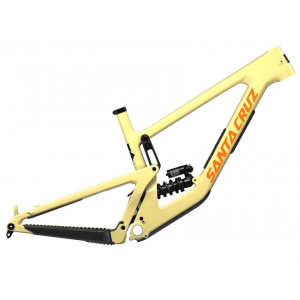

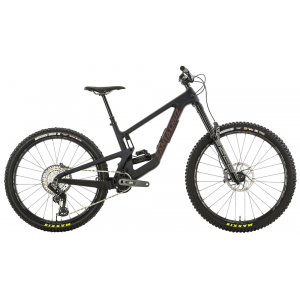
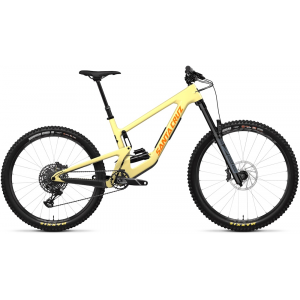
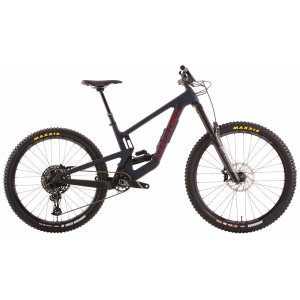
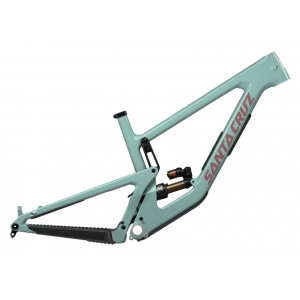
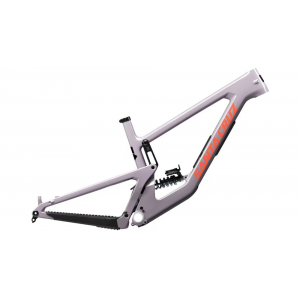
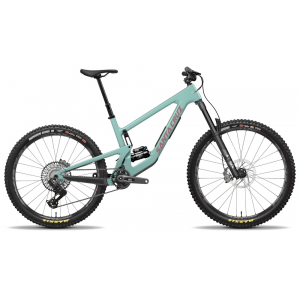





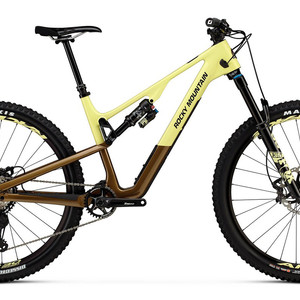

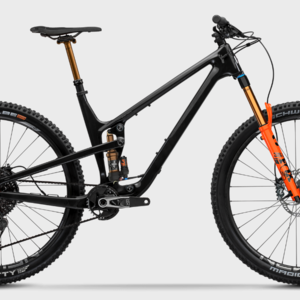

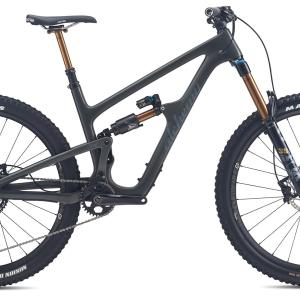








14 comments
Post a reply to: 2015 Test Sessions: Santa Cruz Nomad Carbon X01